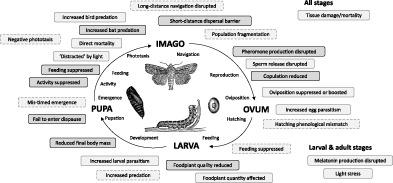当前位置:
X-MOL 学术
›
Insect Conserv. Divers.
›
论文详情
Our official English website, www.x-mol.net, welcomes your
feedback! (Note: you will need to create a separate account there.)
Is light pollution driving moth population declines? A review of causal mechanisms across the life cycle
Insect Conservation and Diversity ( IF 3.2 ) Pub Date : 2020-09-13 , DOI: 10.1111/icad.12447 DOUGLAS H. BOYES 1, 2, 3 , DARREN M. EVANS 2 , RICHARD FOX 3 , MARK S. PARSONS 3 , MICHAEL J. O. POCOCK 1
中文翻译:

光污染驱使蛾类数量下降吗?回顾整个生命周期中的因果机制
更新日期:2020-09-13
Insect Conservation and Diversity ( IF 3.2 ) Pub Date : 2020-09-13 , DOI: 10.1111/icad.12447 DOUGLAS H. BOYES 1, 2, 3 , DARREN M. EVANS 2 , RICHARD FOX 3 , MARK S. PARSONS 3 , MICHAEL J. O. POCOCK 1
Affiliation

|
- The night‐time environment is increasingly being lit, often by broad‐spectrum lighting, and there is growing evidence that artificial light at night (ALAN) has consequences for ecosystems, potentially contributing to declines in insect populations.
- Moths are species‐rich, sensitive to ALAN, and have undergone declines in Europe, making them the ideal group for investigating the impacts of light pollution on nocturnal insects more broadly. Here, we take a life cycle approach to review the impacts of ALAN on moths, drawing on a range of disciplines including ecology, physiology, and applied entomology.
- We find evidence of diverse impacts across most life stages and key behaviours. Many studies have examined flight‐to‐light behaviour in adults and our meta‐analysis found that mercury vapour, metal halide, and compact fluorescent bulbs induce this more than LED and sodium lamps. However, we found that ALAN can also disrupt reproduction, larval development, and pupal diapause, with likely negative impacts on individual fitness, and that moths can be indirectly affected via hostplants and predators. These findings indicate that ALAN could also affect day‐flying insects through impacts on earlier life stages.
- Overall, we found strong evidence for effects of artificial light on moth behaviour and physiology, but little rigorous, direct evidence that this scales up to impacts on populations. Crucially, there is a need to determine the potential contribution of ALAN to insect declines, relative to other drivers of change. In the meantime, we recommend precautionary strategies to mitigate possible negative effects of ALAN on insect populations.
中文翻译:

光污染驱使蛾类数量下降吗?回顾整个生命周期中的因果机制
- 夜间环境通常通过广谱照明被照亮,并且越来越多的证据表明,夜间人造光(ALAN)对生态系统有影响,可能导致昆虫种群减少。
- 蛾类物种丰富,对ALAN敏感,并且在欧洲经历了衰落,使其成为更广泛地研究光污染对夜间昆虫影响的理想之选。在这里,我们采用生命周期方法来回顾ALAN对飞蛾的影响,并借鉴生态,生理学和应用昆虫学等一系列学科。
- 我们发现在大多数生命阶段和主要行为中存在多种影响的证据。许多研究检查了成年人的逃逸行为,我们的荟萃分析发现,汞蒸气,金属卤化物和紧凑型荧光灯比LED和钠灯更容易诱发这种情况。但是,我们发现ALAN还可能破坏繁殖,幼虫发育和,滞育,可能对个体适应性产生负面影响,而且飞蛾可能会通过寄主和捕食者间接受到影响。这些发现表明,ALAN还可以通过影响早期生命阶段来影响日间飞行的昆虫。
- 总体而言,我们找到了有力的证据来证明人造光对蛾的行为和生理有影响,但很少有严格的直接证据表明这会扩大对种群的影响。至关重要的是,相对于其他变化驱动因素,有必要确定ALAN对昆虫数量下降的潜在贡献。同时,我们建议采取预防措施以减轻ALAN对昆虫种群的可能的负面影响。











































 京公网安备 11010802027423号
京公网安备 11010802027423号